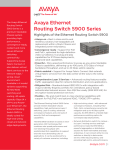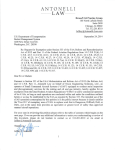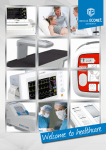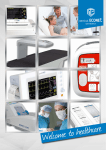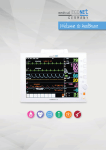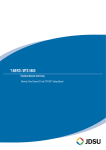Download Business Class DSL Routers and Gateways
Transcript
DSL Technical Track MODULE 3: BUSINESS CLASS DSL ROUTERS AND GATEWAYS ........................................................................1 BUSINESS CLASS ROUTER AND GATEWAY SOLUTIONS OVERVIEW..................................................................................... 1 EFFICIENT NETWORKS BUSINESS CLASS ROUTER AND GATEWAY DETAILS...................................................................... 2 Efficient Networks 5800 Business Class Router................................................................................................................2 Efficient Networks 5900 Business Gateway.......................................................................................................................3 EFFICIENT NETWORKS ROUTER AND GATEWAY SERVICE COMPATIBILITY........................................................................ 4 Efficient Networks 5800 Business Class Routers: Installation.......................................................................................5 Efficient Networks 5900 SHDSL Business Gateways: Installation................................................................................8 EFFICIENT NETWORKS 5800 S AND 5900 S: A FEW DIFFERENCES....................................................................................... 11 5851—Business Class SDSL Router..................................................................................................................................11 5861—Business Class ADSL Router .................................................................................................................................11 5871—Business Class IDSL Router...................................................................................................................................11 5950—Business Class SHDSL Gateway...........................................................................................................................11 ROUTER AND GATEWAY M ANAGEMENT FEATURES............................................................................................................. 12 Service Provisioning & Monitoring Options...................................................................................................................12 LAN, ROUTER, AND GATEWAY SECURITY............................................................................................................................ 13 Network Address Translation: NAT and NAPT...............................................................................................................13 Network Security: IP Filtering Firewall...........................................................................................................................13 Remote Access Security: Virtual Private Networking ....................................................................................................13 Router and Gateway Security: Access Control................................................................................................................14 GATEWAY HIGH A VAILABILITY FEATURES........................................................................................................................... 15 Dial Backup...........................................................................................................................................................................15 VRRP.......................................................................................................................................................................................15 BUSINESS CLASS DSL ROUTERS AND GATEWAYS: QUESTIONS ........................................................................................ 16 Notes for Reviewers: § § § § Items in [TBD: brackets] are comments and/or place holders and are not part of the copy. Some comments are embedded in the document using Word’s “comment” feature and are indicated onscreen by text highlighted in yellow. To see the comments, place the mouse pointer over the highlighted text. These comments can be printed by selecting the “Comments” check box in Word’s printing options dialog. The graphics within this draft are adapted from a variety of Efficient Networks publications. They serve only as suggestions and to give an idea of the final product’s appearance. The pagination and layout shown in this document are suitable for copy review only and do not represent or imply final design layout. Draft History: 04/27/01—First draft submitted for review. 05/25/01—Second draft submitted for review. 06/19/01—Third draft submitted for review. Incorporated feedback from Stewart Hulett. 09/05/01—Fourth draft submitted for review. Added 5900 series (5950 SHDSL Business Gateway). Dod/Pritchard Communications Efficient University Technical Track Copy -- Draft 4: September 5, 2001-- Module 3: Business Class DSL Routers and Gateways Topics in this module: o o o o o Efficient 5800 xDSL Business Class Routers (5851, 5861, and 5871): installation and applications Efficient 5900 SHDSL Business Gateway (5950): installation and applications Router and gateway management features, including provisioning and monitoring Router and gateway security features, including NAT & NAPT, VPN, and access control High-availability gateway features such as VRRP and Dial Backup (brief; detailed in another module) Business Class Router and Gateway Solutions Overview Communications infrastructure is critically important to any business: reliability, high-performance, and flexibility are vital for success. Efficient Networks’ Business Class Routers and gateways meet the needs of business users and feature high-reliability, robust feature sets, and ease of installation and management. The products support connectivity needs for businesses of all sizes, from small firms to corporations, including branch or inter-office and teleworker connectivity. Efficient Networks router and gateway benefits include: o o o o o o o o Business class operation: Reliable high-performance meets the needs of busines s users Always-on, high-speed communications: Up to 125 times faster that dial-up connections Multi-user support: Simultaneous connectivity for hundreds of networked users Strong business class firewall security: For protecting the business network from outside intrusion Robust VPN: Virtual Private Networking option allows secure remote access into network Web-based management: Simple and direct access to gateway and router management Network compatibility: Multi-port Ethernet connections to client-side network Broad OS support: Works with any client-side operating system that supports TCP/IP and Ethernet Recommend a montage of Business Class Router and gateway products here (5800 and 5900 series) here. Figure 1: Efficient Networks’ business c lass products provide high-performance, multi-user connectivity, and strong security. Multiple products make up Efficient Networks’ Business Class Router and Gateway lines. Routers are Efficient Networks’ 5800 series products and include the 5851, 5861, and 5871 models. Gateways are Efficient Networks’ 5900 series products and include the 5950 SHDSL model. 1 Dod/Pritchard Communications Efficient University Technical Track Copy -- Draft 4: September 5, 2001-- Efficient Networks Business Class Router and Gateway Details Digital subscriber line (DSL) is an ideal business class Internet access tool: it’s fast, reliable, and economical. DSL provides transmission speeds equal to or better than many traditional high-speed options for business, at a fraction of the cost. If multiple computers are to be supported, a business class DSL router or gateway easily provides access for all networked systems, or forms the basis of a new internal network if one is not already in place. To really take advantage of DSL’s benefits, however, it’s important to select a business class device with the right capabilities and performance. Efficient Networks business class products are engineered to be the perfect DSL delivery solution for a variety of customer applications: they excel at providing all networked users with lightningfast Internet access and simultaneous, always-on access to e-mail, the Web, and all other Internet-related services. Efficient Networks business class products deliver because they’re versatile. The various models support each of the commonly available DSL types—ADSL, SDSL, IDSL, and SHDSL. All associated models have the same software and feature set, but each uses hardware and software fine tuned for a specific type of DSL service. Efficient Networks business class products are also secure. They include advanced routing capabilities, like IP/IPX routing, bridging, network address translation (NAT and NAPT), dynamic host configuration protocol (DHCP) for auto-configuration of networked systems, a built-in IP filtering firewall, VRRP, dial backup, and optional secure Virtual Private Network (VPN) capability. Very important for growing organizations, Efficient Networks routers and gateways are scalable, too. As the network grows, Efficient Networks business class products scale to fit new needs—easily supporting new or multiple network configurations and providing simultaneous Internet access for hundreds of users. Efficient Networks 5800 Business Class Router The Efficient Networks 5800 Business Class router series includes three products: the 5851, 5861, and 5871. All three are virtually identical in terms of features and benefits. They differ only in the type of DSL service type with which they’re designed to work: Symmetric DSL (SDSL), Asymmetric DSL (ADSL), and Integrated Services Digital Network DSL (IDSL). Figure 1: The Efficient Networks 5800 Business Class Router. Efficient Networks 5800 Business Class Router Facts o o o o o o Value-packed routing for small-to-medium organizations. Always-on connectivity to the Internet. High-speed access: Up to 8 Mbps downstream & 1 Mbps upstream for ADSL and up to 2.3 Mbps (up and downstream) for SDSL. Easy installation and configuration for multi-user connectivity. Advanced security features, with built-in firewall and optional VPN. Support for a wide range of high bandwidth applications. 2 Dod/Pritchard Communications Efficient University Technical Track Copy -- Draft 4: September 5, 2001-o o o o o o o o o Fast, tool-free LAN-side installation through a 10BaseT Ethernet port. Function management via built-in Web user interface. NAT support allows multiple devices to share a single WAN-side IP address. DHCP for automatic assignment of IP addresses to LAN-side systems. Firewall security keeps unwelcome guests out of the internal network. Secure VPN option protects point-to-point data transfer across the Internet. Compatible with all operating systems that support the TCP/IP protocol and Ethernet connectivity. Assured interoperability with data networks worldwide. Software upgradeability ensures operation with future service enhancements. Efficient Networks 5900 Business Gateway The Efficient Networks 5900 series includes the 5950 SHDSL Business Gateway. Designed specifically for the newly approved Symmetric High-density Digital Subscriber Line standard, the 5950 SHDSL Business Gateway delivers higher-speed service and can be deployed to customers previously deemed unreachable by DSL technology. Figure [x]: The Efficient Networks 5900 SHDSL Business Gateway. Efficient Networks 5900 SHDSL Business Gateway Facts Many of the features of the 5800 Business Class Router are supported in the 5900 SHDSL Business Gateway, including: o o o o o o o Gateway operation for a variety of business types and sizes. Always-on connectivity to the Internet. Easy, tool-free installation and graphical configuration tools. Advanced security and features, including a robust firewall and a VPN option. NAT and DHCP support Compatibility with all operating systems that support TCP/IP and Ethernet. Software upgradeability. In addition, the 5900 Business Gateway offers the following: o o o o o Integrated eight port 10/100Base-T Ethernet switch for optimal LAN connection flexibility High-speed access: Up to 2.3 Mbps up/downstream per line (up to two lines can be supported) Standards-based, symmetric DSL technology ensures wide compatibility with provider equipment High availability operation through Virtual Redundant Routing Protocol (VRRP) and Dial Backup. [TBD: Is this all there is in terms of differences? What am I missing? –MAC] 3 Dod/Pritchard Communications Efficient University Technical Track Copy -- Draft 4: September 5, 2001-- Efficient Networks Router and Gateway Service Compatibility 5851 SDSL Business Class Router The 5851 is designed for Symmetric DSL (SDSL) service. SDSL has equal upload (customer to Internet) and download (Internet to customer) speeds, is typically used for business, and requires installation of a separate, dedicated service line. SDSL data transmission speeds vary from 160 thousand bits per second (160 kbps) to 2.3 million bits per second (2.3 Mbps), depending on the distance between the customer site and the telephone company’s “central office” (usually, the “CO” is the location at which subscriber lines are connected to the telephone network). The maximum customer-to-CO distance for SDSL is about 22,000 feet in line length (about 4.1 miles), a little farther than ADSL (see below). 5861 ADSL Business Class Router The 5861 works with Asymmetric DSL (ADSL). ADSL is very popular in both business and residential applications, as it can be delivered over an existing telephone line without affecting standard telephone operation. The term “asymmetric DSL” comes from the service’s different upload and download speeds. The download speed of a typical ADSL service may be up to 10 times higher than its upload speed. This works well for many applications, as the amount of downloaded data often exceeds the amount uploaded. The fastest available ADSL download speed is 8 Mbps (more than 125 times faster than a dial-up connection). The top upload speed ranges between 640 kbps and 1 Mbps, depending on specific service offerings. ADSL works at line-length distances up to 18,000 feet (about 3.4 miles) from the CO, the shortest distance of the three DSL services described here. 5871 IDSL Business Class Router The 5871 works with DSL based on the Integrated Systems Digital Network (ISDN) standard. IDSL offers an always-on alternative to ISDN’s digital dial-up connections. Like SDSL, IDSL features equal upload and download speeds, but at a slower rate of 144 kbps (nearly three times the speed available to dial-up 56k modem connections, however). Although it does not provide speeds as high as ADSL or SDSL, IDSL has the advantage of extending to greater distances from the CO. The maximum distance allowed from the customer site to the CO for IDSL is approximately 35,000 feet in line length (about 6.6 miles). IDSL is often used to reach homes and businesses that are too far from a CO for ADSL or SDSL but still need an always-on, fast connection. Like SDSL, IDSL requires installation of a separate dedicated service line and does not support simultaneous voice communication over that same line. 5950 SHDSL Business Gateway The Efficient Networks 5950 works with a DSL variant called SHDSL, for Symmetric High-density Digital Subscriber Line. The SHDSL standard improves on the bandwidth and reach capabilities of other DSL implementations and employs their best features to provide up to two symmetric channels operating at 2.3 Mbps each (for a possible total throughput of 4.6 Mbps). The maximum customer-to-CO distance for SHDSL is 20,000 feet (about 3.8 miles), but it can be extended substantially though the use of in-line repeaters. This means SHDSL can deliver high-speed connectivity to many customers previously deemed unreachable by DSL technology. SHDSL is especially well suited for businesses as it easily addresses the needs of small and mid-size businesses, enterprise branches, and teleworkers. SHDSL also supports a range of applications with the flexibility to allow for tailored solutions. 4 Dod/Pritchard Communications Efficient University Technical Track Copy -- Draft 4: September 5, 2001-- Efficient Networks 5800 Business Class Routers: Installation One of the hallmarks of Efficient Networks 5800 Business Class Routers is their ease of installation. The typical router installation is simple and goes very quickly. To set up the router initially, the following installation requirements must be met. Computer and Network Service Provider (NSP) Requirements A computer is used to configure and manage the router. The computer can be connected directly to the router with either the console cable (included with the router) or through an open Ethernet jack (see Figure 2 below). Any computer that has the following components can be used: o o o o CD-ROM or DVD drive. TCP/IP networking enabled. Web browser or terminal emulation software. Ethernet or serial port (RS-232) connection. (The Web interface works over TCP/IP. The serial port/console connection provides detailed configuration of elements not accessible through the Web interface.) The network service provider (NSP) provides information on the protocol to be used by the connection. It should be one of the following: o o o o Point-to-Point Protocol over ATM (PPP). (Requires a user name and password.) Point-to-Point Protocol over Ethernet (PPP) (Requires a user name and password.) RFC 1483 (SNAP encapsulation). (Or RFC 1490 if Frame Relay is used in place of ATM.) RFC 1483 MER (MAC Encapsulated Routing—requires a WAN gateway IP address). 5800 Configuration Defaults: VPI/VCI DSL router configurations make use of two numbers called Virtual Path Identifier (VPI) and Virtual Channel Identifier (VCI). Both terms are related to DSL service deployed over an Asynchronous Transfer Mode (ATM) network. The VPI indicates the virtual path over which data is routed between the router and the NSP’s network. Similarly, the VCI identifies the virtual communications channel over which data travels between customer premises and the NSP. [TBD: Is it important to provide specific default settings for this section, or are we okay with talking about defaults in a more general way, as we have done here?] Efficient Networks routers are usually pre-configured with VPI/VCI numbers according to the region in which they are deployed. If the router isn’t already configured, or if it’s configured for a different NSP, it will be necessary to obtain these numbers from the NSP and then configure the router with them. In addition, when connecting to multiple remote sites, additional VPI and VCI numbers are needed from the NSP. These numbers identify remote destinations and must be unique for each remote. 5800 Configuration Defaults: Encapsulation A variety of encapsulation options are available in the 5800. As for VPI/VCI, it’s important for the encapsulation setting to match that of the NSP. Efficient Networks Business Class Routers are generally pre-configured for specific services, but it’s easy to modify the setting if a change is necessary. The encapsulation methods supported by the 5800 include: o o o o o o Point-to-Point Protocol (PPP) PPP Logical Link Control (PPPLLC) RFC 1483 (for ATM) or RFC 1490 (for Frame Relay) RFC 1483 MER (MAC Encapsulated routing, for ATM) or RFC 1490 MER (for Frame Relay) FRF8 rawIP Complete information about how these protocols are configured within the Efficient Networks 5800 Business Class Router is provided on the installation CD included with every router. 5 Dod/Pritchard Communications Efficient University Technical Track Copy -- Draft 4: September 5, 2001-- Typical 5800 Installation Connections Installation of the 5800 Business Class Router is quick and straightforward. The router should be placed in a wellventilated location, not stacked with other devices or placed on carpeting. Powering the router through an appropriate surge protection device is recommended. Basic cabling for connecting one computer to the router is included with each product (see 5800 Package Contents, below). The DSL jack connects directly to the WAN port of the 5800 router, while the built-in Ethernet hub connects directly to an Ethernet-equipped computer or to another network hub or switch. (See Figure 2.) Figure 2: The typical Efficient Networks 5800 Business Class Router installation is easy; all cables needed for a basic configuration are included with the router. 5800 Front Panel Indicators Six front panel indicators provide continuous status information for the DSL service and for the router itself. The indicators provide the customer with a convenient way to determine that the router and service are operating properly. As shown in the table below, the indicators can be off, yellow, or green, with each color giving different information. Figure x: The front panel indicators of Efficient Networks 5800 Business Class Routers. 6 Dod/Pritchard Communications Efficient University Technical Track Copy -- Draft 4: September 5, 2001-- Indicator 5800 Front Panel Indicators Off Yellow PWR Power is off. TEST Router is shut down. LINK WAN LANT LANR n/a Running power-on self test. DSL link establishment in process. DSL modem link is shut down. No wide area network (WAN) traffic detected. n/a No LAN traffic present. No LAN traffic is present. n/a Green Power is on. Router power-on self test completed. Router OK. DSL modem link established. Flashing: WAN traffic detected. Flashing: Router is transmitting LAN traffic. Flashing: Router is receiving LAN traffic. 5800 Easy Setup: Web-based Router Configuration The Efficient Networks 5800 Business Class Router includes a Web user interface called Easy Setup designed to provide quick access to router controls and information. Easy Setup is a set of Web forms designed to provide quick and easy setup of the router. It’s always available and is accessible through a standard Web browser. Easy Setup uses a basic configuration to get a router up and running. The configuration is easily customized with information about the local area network (LAN) and information from the NSP. The following settings can be accessed through Easy Setup: o o o o o o o Wide Area Network (WAN) interface protocol and VPI/VCI settings Protocol encapsulation settings, including: PPPoA, PPPoE, RFC 1483 or 1490 Dynamic Host Configuration Protocol (DHCP) LAN IP Configuration (the LAN IP address of the router) Network Address Translation (NAT) server mappings Low, Medium, and High settings for the Firewall IPSec configuration (if Secure VPN option is installed) Easy Setup screen shot Figure x: Easy Setup makes router configuration and maintenance a breeze. Once Easy Setup has been used to configure the minimum settings needed for essential router functions, additional configuration and advanced router features can be controlled through the Command Line Interface (CLI). The CLI is available for network technicians who need direct access to all router features. 5800 Package Contents All Efficient Networks 5800 Business Class Routers are shipped with one each of the following items: o o o o o The router (a 5851, 5861, or 5871 model, depending on the DSL connection type) Installation CD Quick Start Guide in the CD jacket Ethernet 10Base-T cable for straight-through or console connections; with RJ-45 connectors and a red label Ethernet 10Base-T cable for crossover connections; with RJ -45 connectors and a yellow label 7 Dod/Pritchard Communications Efficient University Technical Track Copy -- Draft 4: September 5, 2001-o o o o Serial port adapter: RJ-45 to DB-9 DSL data cable for straight-through connections; with RJ-14 connectors and purple label (5861 only) Standard power cord Product release notes Efficient Networks 5900 SHDSL Business Gateways: Installation Efficient Networks 5950 gateways install very quickly with supplied software and cabling. Below are a few of the important provider and computing environment settings to be used. 5950 Computer and Network Service Provider (NSP) Requirements o o o o o o CD-ROM or DVD drive. Ethernet network interface card. TCP/IP network protocol installed. Web browser—needed for most configuration functions. RS-232 (serial) COM port--needed only for detailed configuration of elements not accessible through the Web interface. Terminal emulation software if you want to configure your router via your computer’s serial port before placing it into service on a network. The network service provider (NSP) provides information on the protocol to be used by the connection, including: o o o o DNS address One or more LAN IP addresses and a subnet mask Protocol to use. Should be one of the following: – PPP (Point-to-Point Protocol), with a user name and password – PPPoE (PPP over Ethernet) – RFC 1483 (SNAP Encapsulation) – RFC 1483 MER (MAC Encapsulated Routing, requiring a WAN gateway address) – VCI (PVC) numbers Network options: – Bridging – IP Routing (requires a WAN IP address and subnet mask) 5950 Configuration Defaults: VPI/VCI As for the 5800 routers, the Efficient 5950 SHDSL Business Gateways uses two service-specific numbers called VPI and VCI to determine the paths used for communication between the 5950 and the NSP. 5950s are preconfigured with VPI/VCI numbers according to the region in which they are deployed. If the gateway isn’t already configured, of if it’s configured for a different NSP, it will be necessary to obtain these numbers from the NSP and then configure the 5950 to match. In addition, when connecting to multiple remote sites, additional VPI/VCI numbers are needed from the relevant NSPs. VPI/VCI numbers must be unique for each remote. Changes to VPI/VCI settings can be made through Efficient’s Easy Setup, which is accessible through a standard Web browser. 5950 Configuration Defaults: Encapsulation A variety of encapsulation methods are available in the 5950. The encapsulation setting must match that of the NSP. Efficient Networks Business Gateways are generally pre-configured for specific services, but it’s easy to modify the setting if a change is necessary. Encapsulation can be changed through Easy Setup. 8 Dod/Pritchard Communications Efficient University Technical Track Copy -- Draft 4: September 5, 2001-- 5950 Typical Installation Connections Installation connections for the 5950 SHDSL Business Gateway are very easy. Begin by locating the 5950 in a wellventilated location, not stacked with other devices. Powering the unit through a suitable surge protection device is recommended. Basic cabling included with the 5950 (see 5950 Package Contents, below) enables connection of a single computer to the gateway. The DSL connection jack (supplied by the NSP) connects directly to the WAN port of the 5950, while the Ethernet switch connects directly to any Ethernet-equipped comp uter or to another switch or hub. Figure x: The back of the 5950 SHDSL Business Gateway, showing multiple computers connected directly to its built-in Ethernet switch. The 5950 can also connect to an Ethernet switch (or hub) to provide connections for additional users. 5950 Front Panel Indicators Four front panel indicators provide continuous status information for the DSL service and for the gateway itself. The indicators provide the customer with a convenient way to determine that the gateway and service are operating properly. As shown in the table below, the indicators can be off, yellow, or green, with each color giving different information. Insert image of 5900 with front panel indicators clearly visible. Figure x: The front panel indicators of Efficient Networks 5900 SHDSL Business Gateways. Indicator Power Test WAN LAN 5950 Front Panel Indicators Off Yellow Power is off. Running power-on self test (POST). DSL link establishment in process. Router is shut down. DSL link is unavailable. No WAN traffic present. n/a 9 Green Power is on. Router power-on self test completed. Router OK. DSL link is OK. Flashing: WAN traffic detected. Dod/Pritchard Communications Efficient University Technical Track Copy -- Draft 4: September 5, 2001-- 5950 Easy Setup: Web-based Router Configuration The 5950 features Easy Setup configuration accessible through a standard Web browser. Easy Setup provides quick and direct access to nearly all of the gateway’s configuration and control settings, including: o o o o o o o WAN interface and VPI/VCI settings Protocol encapsulation settings Dynamic Host Configuration Protocol (DHCP) LAN IP Configuration (the LAN IP address of the gateway) Network Address and Network Address Port Translation (NAT and NAPT) server mappings Low, medium, and high firewall configurations, plus access to custom settings Secure VPN configuration (if VPN option is installed) 5950 Package Contents All Efficient Networks 5950 SHDSL Business Gateways include one each of the following items: o o o o o o o One Efficient Networks 5900 Series Business Gateway One Efficient Networks Installation CD-ROM One AC power supply module and cord One Ethernet cable, RJ-45, red label (straight through) One Ethernet cable, RJ-45, yellow label (crossover) One RJ-45 to DB-9 serial port adapter (console) Customer Release Notes 10 Dod/Pritchard Communications Efficient University Technical Track Copy -- Draft 4: September 5, 2001-- Efficient Networks 5800s and 5900s: A Few Differences As previously discussed, there are many similarities in capabilities, management, and security features between the 5800 routers and the 5900 gateway. The primary differences are related to the types of DSL service for which the device is designed to operate. The following lists provide key model-specific difference information. 5851—Business Class SDSL Router • • • • Data rates from 160 kbps to 2.3 Mbps 2B1Q modulation, SDSL, RJ-45 Interface Built-in 4 port Ethernet hub (four RJ-45 connectors) ATM or Frame Relay support on the same hardware platform 5861—Business Class ADSL Router • • • • • • • Data rates of up to 8 Mbps downstream, and 640 Kbps upstream ADSL, RJ-14 WAN interface ADSL, full rate G.dmt, T1.413, and G.lite router with service type auto-sensing Fully compatible with ADSL/POTS (data/voice) splitters Analog telephone line support Cooperation with an external splitter [TBD: LAN side connector?] 5871—Business Class IDSL Router • • • • • Data rates of 64, 128, or 144 kbps ISDN 2B1Q modulation, IDSL, RJ-45 interface Firewall prevents unauthorized LAN access Multi-user connection sharing via Ethernet LAN Built-in 4 port Ethernet hub (four RJ-45 connectors) 5950—Business Class SHDSL Gateway • • • • • • Data rates up to 2.3 Mbps per installed line (maximum of two lines) SHDSL RJ-45 WAN interface Optional VPN operation with full wire -speed throughput Up to two lines supported for 2.3 Mbps operation for upload and download Built-in 8 port Ethernet switch (eight RJ-45 connectors) [TBD: Any others that stand out?] 11 Dod/Pritchard Communications Efficient University Technical Track Copy -- Draft 4: September 5, 2001-- Router and Gateway Management Features Service Provisioning & Monitoring Options Efficient Networks Business Class Routers and Gateways offer three methods for accessing settings and options. All are easy to use, but the first is particularly convenient and does not require a lot of networking expertise on behalf of the user. The latter two options use a non-graphical, command line interface (CLI) and thus require greater familiarity with network and network devices. On the other hand, the CLI also provides direct access to all router and gateway features and therefore also offers the greatest level of control and customization. 1. Easy Setup (discussed earlier) is a graphical user interface that can be accessed from a standard Web browser. Easy Setup can be used to view and/or change router or gateway configuration, is easy to use, and cycles through the typical settings. 2. Router and gateway management can also be accomplished by connecting a computer serial port directly to the console port, using the console cable and connector supplied for this purpose. On the computer, a terminal emulation program (such as the HyperTerminal applet included with Windows) set to emulate a standard VT100 terminal establishes the direct PC-to-CPE the connection. Once connected and logged in, direct commands can be issued to list and/or change settings and to monitor router or gateway operation. 3. A third router and gateway management option is Telnet. Telnet provides remote terminal-style access similar to the direct console connection but over the network instead; a physical connection to the router or gateway is not necessary. Once connected via Telnet, the same management and monitoring functions are available as through the console connection. 12 Dod/Pritchard Communications Efficient University Technical Track Copy -- Draft 4: September 5, 2001-- LAN, Router, and Gateway Security Network Address Translation: NAT and NAPT Network Address Translation (NAT) allows LANs to use one set of IP addresses internally and a second, different set of addresses externally. A related standard called Network Address Port Translation (NAPT) translates both IP (device) and port (e.g., Web, FTP, and Telnet) addresses. In a typical application, NAT and NAPT are used to allow a very large number of simultaneous (internal) connections using only a single global (external) address representing the entire private network. To the outside world it looks as if all nodes inside the private network are processes within the router or gateway (the only device with an externally visible IP address and/or port address). The computers behind the NAT-enabled router or gateway can access the Internet, but people and other systems on the Internet can’t access the computers inside the LAN. NAT therefore provides a first line of defense against intrusion from the outside world: by hiding internal, LAN IP addresses, NAT provides a simple type of firewall. Outside the LAN, all traffic appears to originate from the single provider-supplied address, and detection of systems and capabilities on the customer LAN side of the router or gateway is very difficult. NAT can further facilitate hosting of Web, FTP, and mail servers on a LAN, thereby providing greater flexibility for the customer. Efficient Networks 5800 Business Class Routers and the 5950 SHDSL Business Gateway support both NAT and NAPT, and NAT supports multiple PPTP clients and one server per e xternal (provider-supplied) IP address. (Additional information on NAT, NAPT, and related applications is available in Module 4: Routing Fundamentals.) Network Security: IP Filtering Firewall The Efficient Networks 5800 Business Class Router and 5950 SHDSL Business Gateway use an IP filtering firewall to check network traffic flow. The filtering process involves examination of data packets received from one interface to determine whether to route them to another interface or to discard them. When filtering packets, the router or gateway examines information such as the source and destination addresses contained in the IP packet, the type of connection, etc., and then screens (filters) the packets based on its configuration; packets are either allowed to be forwarded or simply discarded. IP filtering allows the customer (and/or the service provider) to define specific protections for an entire local area network (LAN). In addition, a “forward” filter makes it possible to configure filtering for both inbound and outbound packets with fewer commands—a valuable feature when configuring a firewall in LAN-to-LAN or WANto-WAN situations. Filter sets within the 5800 series routers and 5950 gateway are easily configured, and basic filter sets are available at the Efficient Networks Web site (www.efficient.com). For troubleshooting purposes, 5800 series routers and the 5950 gateway can be configured to generate a log of hostile or unusual activity. This tracks packet number and structure and can be examined by a network administrator or service provider to help determine how rules need to changed (or which rules need to be added) to fine tune the firewall. (More information on firewalls and how they are used appears in Module 4: Routing Fundamentals.) Remote Access Security: Virtual Private Networking VPN is a method for establishing direct and secure point-to-point connections, often from one computer to a remote network or from network to network. Sometimes called tunneling, VPN services typically include encryption and other mechanisms to ensure that transferred data is protected against interception or hijacking. In the 5800 series routers and the 5950 gateway, tunneling can originate within the router or gateway rather than at the desktop. This has several advantages. First, since no software need be installed at the desktop, the service is easier to deploy. VPN at the CPE is also more efficient and provides better performance, and some devices include 13 Dod/Pritchard Communications Efficient University Technical Track Copy -- Draft 4: September 5, 2001-- hardware-based VPN acceleration for continuous optimization. (Additional information about VPN technology and its applications is available in Module 5: Advanced Router Features.) The VPN option in Efficient Networks routers and gateways is activated through a simple, user-installable software license key. No reconfiguration of the router or gateway is required. The key is a 44-character string, unique to a particular router or gateway, that enables a this particular feature. A software option key can be entered through either the Web or command line interfaces. The key is available for purchase from product distributors, directly from Efficient Networks, or from the Efficient Web site: www.efficient.com. Router and Gateway Security: Access Control Router and gateway access controls are important to ensure the s ecurity of the device and its settings. 5800 series routers and 5950 gateways have flexible controls, including password protection, port- and service-based controls, and IP range controls. The 5800 series router and 5950 gateway always prompt for a password upon connection. A default password is provided (and listed in the documentation), and changing it upon first use is highly recommended. Changing the password secures the router or gateway and its configuration against unauthorized tampering, from both inside the client LAN as well as from the outside world (i.e., the Internet). Router and gateway access control can also restrict administrative access and control to a select group of hosts by IP range. IP addresses on either side (LAN or WAN) of the router or gateway may be specified. For example, if a 5950 gateway is set to allow access to internal systems within the LAN IP range from 192.168.254.0 to 192.168.254.254, systems with other IP addresses are denied access to gateway settings. (Those systems outside the IP range specific for the gateway are still able to use the Internet connection as usual; their only access restriction is gateway control functions.) Access to 5800 series routers and 5950 gateways may also be restricted according to “direction,” whether a connection request comes from within the LAN or outside of it (i.e., from the Internet). It’s also possible to mix and match the types of services that can be accessed. An outsider might not be able to access the router or gateway via Telnet, for example, while LAN side users have full Telnet access. The router and gateway services that can be accessed from computers can also be controlled. Access control can be used to: o o o Enable or disable LAN-based computer access to specific services Enable only LAN-based computers to manage router/gateway services Allow all hosts (on or outside the LAN) to manage router/gateway services Access-controlled services include: o o o o Telnet management Web management SNMP management System logging to syslog-servers 14 Dod/Pritchard Communications Efficient University Technical Track Copy -- Draft 4: September 5, 2001-- Gateway High Availability Features The Efficient Networks 5950 SHDSL Business Gateway includes advanced, high availability Dial Backup and VRRP features that enable uninterrupted communications service. Complete information about these features appears in Module 5: Advanced Router Features. Dial Backup Dial Backup provides a backup connection to the Internet through an external V.90 or ISDN modem, connected to the console port of the gateway. This backup connection can be activated in the event of a DSL service interruption. During an interruption, the gateway uses the dialup modem connection while waiting for DSL service to be restored. Once the DSL link is live, Dial Backup automatically switches data flow back to the DSL service. VRRP When a gateway is the only means for routing available, it becomes the critical link in the network. If the gateway or its DSL connection fails, the link and connection are broken. To protect against this kind of failure, it’s often appropriate to set up other gateways or routers as backups, ones that can serve as the default gateway if the primary gateway is unavailable. Virtual Redundant Routing Protocol (VRRP) enables the 5950 SHDSL Business Gateway to define an alternate data path in the event that its connection is interrupted for any reason. [End of Module 3 Lesson Copy] 15 Dod/Pritchard Communications Efficient University Technical Track Copy -- Draft 4: September 5, 2001-- Business Class DSL Routers and Gateways: Questions 1. All of the following are features and benefits of 5800 series routers, except: a. b. c. d. 2. What’s so great about DSL? a. b. c. d. 3. The design, color, and mounting requirement for the router. The type of DSL service with which the router is designed to operate. The number of lights on the front panel. All of the above. Of the following, which is not a computer requirement for installing and configuring an Efficient Networks 5800 router? a. b. c. d. 7. Super Hot DSL. Supremely High-density DSL. Symmetric High-density DSL. South Hampton DSL. What is/are the difference(s) between the three models in the 5800 series routers? a. b. c. d. 6. The 5871. The 5950. The 5851. All of the above. What is SHDSL? a. b. c. d. 5. It’s fast, reliable, and economical. It’s up to 125 times faster than analog dial-up connections. It’s ideal for business and residential customers. All of the above. SDSL is supported by which router model? a. b. c. d. 4. High-speed Internet access for two to 150 simultaneous users. Strong firewall security for the customer LAN. Network optimization through Ethernet translation. Network configuration and management features. A fully operational computer. TCP/IP protocol. A spectrum analyzer. An Ethernet port. What are VPI/VCI settings? a. b. c. d. VPI/VCI settings are not used on the 5800. Settings used to identify paths and channel over which data is exchanged. Identification of remote destinations that must be unique for each remote. Just b and c. 16 Dod/Pritchard Communications Efficient University Technical Track Copy -- Draft 4: September 5, 2001-- 8. How many Ethernet ports are on the 5800 router? a. b. c. d. 9. None. Twelve. Four. Four, but it’s expandable. What are the options for connecting to a 5800 router or 5950 gateway for purposes of configuring it? a. b. c. d. e. Web, SNMP, and Telnet interfaces. A programmable infrared (IR) remote control. Console connection. Only a and c. None of the above. 10. How can the service (CO-to-customer) distance be increased for SHDSL service? a. b. c. d. With longer cables between the customer premises unit and the CO. Through the use of in-line repeaters. It can’t be increased. The maximum distance is fixed at 20,000 feet for SHDSL. Through the use of in-line wireless amplifiers. 11. What’s an IP filtering firewall? a. b. c. d. A set of definitions that provide protection for the LAN connected to the router. A method for examining incoming packets for source and destination addresses. Both a and b. None of the above. 12. Virtual Private Network (VPN) technology is used primarily to a. b. c. d. Provide secure end-to-end connections. Protect against data interception. Protect against connection hijacking. All of the above. 13. What’s the major advantage of a VPN? a. b. c. d. e. It’s virtual, so it doesn’t consume bandwidth. It’s public, so it’s easy to Webcast. It’s networked, so many diverse entities can enjoy the content. It’s similar to the Internet. None of the above. 14. Router access control is important because a. b. c. d. The number of people with access to the router should be limited. It’s not especially important, but it’s in there in case anyone wants to use it. The router should not be freely accessible from the Internet. Just a and c. 17 Dod/Pritchard Communications Efficient University Technical Track Copy -- Draft 4: September 5, 2001-- 15. Important 5800 NAT/NAPT functionality includes all of the following, except: a. b. c. d. Sharing of a single global IP address among a large number of LAN-side systems. Shielding of internal IP addresses from outside detection. Blocking LAN-side systems from accessing the Internet and other services. A first line of defense against malicious attack. 14. What high availability features are offered by the 5950 SHDSL Business Gateway? a. b. c. d. Dial Backup. VRRP. CCCP. Both a and b. [End of Module 3 Questions] 18






















